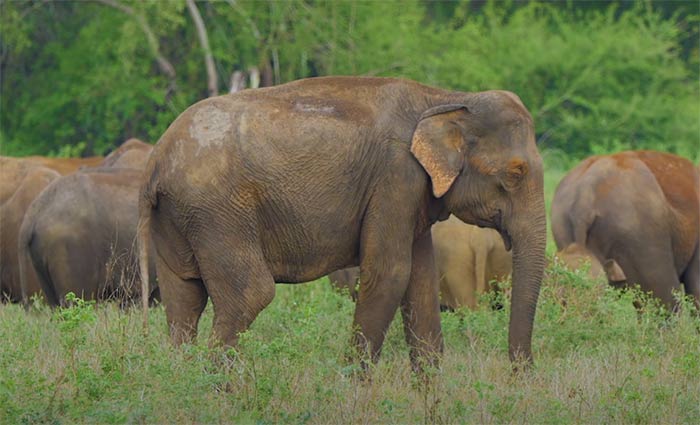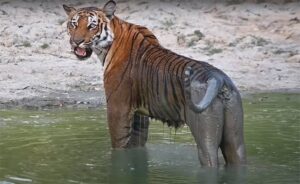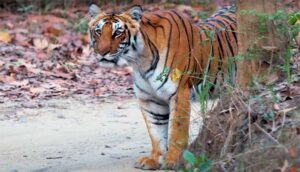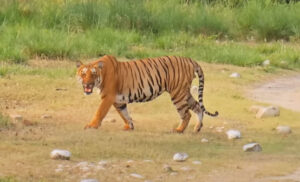Durgadevi is a special area in the Corbett Tiger Reserve. It’s in a place with lots of hills and different landscapes. It’s in the northeastern part of the reserve. Durgadevi has small hills and wide-open spaces, all covered in green plants, making it look really beautiful. You can get there by using the Garhwal road, and the entrance Durga Devi Gate is 42 kilometers away from the main town of Ramnagar. It takes about 1.3 hours to travel there.
Durgadevi is one of the main seven zones in the reserve. It’s famous for having many leopards and different kinds of birds. It’s like a dream come true for people who love watching birds. A lot of tourists visit Durgadevi throughout the year to enjoy its natural beauty.
If you want to explore Durgadevi, you can go on a jeep safari organized by the Corbett administration. They make sure the safari is well-managed so that people can easily see the diverse plants and animals in Durgadevi. It’s a great opportunity for nature lovers to experience the rich variety of life in this area.
What can one see inside the Durga Devi Zone?
This zone situated is on hills and gives you a great view of the whole area covered in greenery. The Ramnaga River starts from Diwali Khal and enters Durgadevi, joining with the Mandal and Ramnagar rivers. The riverside has lots of grassy lands where elephants live. By the river, you can see different wild animals coming for water.
Durgadevi, like other parts of Corbett Tiger Reserve, has many animals and plants that attract a lot of tourists. Some plants you can find there are Sheesham, Sisoo, Dhak, Khair, and others like Chir Pine, Chir Choti, Gajar Sot, Banj Oak, Kanju, Jamun, Amla.
In the park, you can find animals like the Royal Bengal Tiger, Wild Boar, Wild Asian Elephant, and different types of deer such as Spotted Deer, Sambar Deer, Barking Deer, Chital. There are also monkeys like Rhesus Monkey, Black Faced Monkey, and Jackal. Durga Devi zone has a lot more elephants compared to other areas in the reserve.
Flora and Fauna in Durga Devi Zone
This zone is for people who want to enjoy the beauty of nature, not specifically for those who want to see tigers. Although the Durga Devi zone has a significant population of elephants compared to other areas in the reserve. Now, let’s talk about the flora and fauna in this zone.
Flora in the Zone
- Sheesham
- Sisoo
- Dhak
- Khair
- Chir Pine
- Chir Choti
- Gajar Sot
- Banj Oak
- Kanju
- Jamun
- Amla
Fauna in the Zone:
- Royal Bengal Tiger
- Wild Boar
- Wild Asian Elephant
- Spotted Deer
- Sambar Deer
- Barking Deer
- Chital
- Rhesus Monkey
- Black Faced Monkey
- Jackal
Entry Gate of Durga Devi Zone
The entrance to the Durga Devi Zone is through the Durga Devi Gate, which is located 28 kilometers away from Ramnagar. This gate is the farthest one from Ramnagar. If you plan to stay overnight inside the zone, the only place available is the Lohachur Rest House, which is managed by the government. Many tourists choose to stay here to have a better experience with wildlife.
If you want to stay in the jungle and go on a jeep safari, it’s important to book both the safari and the rest house in advance. The Durga Devi Zone is closed for four months from 15th June to 15th October during the monsoon season, and tourists are not allowed in during that time.
Jeep Safari timings & price
This ecotourism zone is situated on hilly land with many rivers. It’s also famous for Mahasheer fishes and bird watching opportunity. This zone offers a distinctive ecological experience.
The Durga Devi Zone is open for exploration from October 15th to June 15th each year. During this time, visitors can enjoy daytime Jeep Safaris. There are two shifts each day, accommodating a maximum of 11 Jeeps per shift. The safari timings for this particular zone are outlined below.
| Winter timings | ||
| Safari Types | Entry Time | Exit Time |
| Morning Safari | 07:00AM | 10:00AM |
| Evening Safari | 02:00PM | 05:30PM |
| Summer timings | ||
| Safari Types | Entry Time | Exit Time |
| Morning Safari | 06:00AM | 09:30AM |
| Evening Safari | 03:00PM | 06:30PM |
Cost of the Jeep Safari
The cost of a Jeep Safari in this zone is contingent upon the number of individuals intending to enter the zone. Each Jeep can accommodate a maximum of 6 adults and 2 children. For a group of 6 people, the cost per Jeep ranges from ₹5500 to ₹6500, with an individual cost varying between ₹900 to ₹1200. The time of exploration is 3:30 hour.
Nearby attractions : Durga Devi Zone
Garjiya Devi Temple (16KM): The renowned Garjiya Devi Temple is situated a mere 16 kilometers from the entrance gate of Durga Devi.
Manila Devi Temple: This unique destination in Uttarakhand Manila Devi Temple is located 54 kilometers from the entry gate of Durga Devi Zone.
Shri Hanuman Dham Temple (36KM): The highly acclaimed Shri Hanuman Dham Temple is a mere 3 kilometers from the entry gate of the Durga Devi Zone.
Sitabani Temple: The well-known Sitabani Temple, associated with the birth of Love and Kush, is located just 50 kilometers away from the entry gate.
Dhangarhi Museum: A popular attraction among tourists, the Dhangarhi Museum, is situated a mere 10 kilometers from the entry gate.
How to Reach Durga Devi Zone
Entry Gate Address – Durga Devi Gate, Kalakhand Village Durga Devi Gate, Bilkot, Deema Range, Uttarakhand 246161, India
Latitude – 29.5734° N, Longitude – N, 79.0906° E
The Durga Devi Zone is conveniently located just 28 kilometers from the city of Ramnagar. If you are traveling from major cities such as Delhi, Bangalore, Gurgaon, Mumbai, etc., your first destination should be Ramnagar. Once in Ramnagar, you can secure a Jeep Safari booking to access the Durga Devi Zone.
It is essential to note that personal vehicles are not permitted within the jungle, and access is granted exclusively through pre-booked Jeep Safaris. The Lohachaur Forest House is the sole accommodation option available for those seeking to stay within the jungle.
Nearest Transportation Hubs
- Nearest Railway Station: Ramnagar (31KM)
- Nearest Bus Stand: Ramnagar (28KM)
- Nearest Airport: Pant Nagar Airport (108KM).
Durga Devi Zone : A Peaceful Escape into Nature’s Lap (Visited January 2021)
I had the chance to explore the Durga Devi Zone of Jim Corbett National Park in January 2021, and while it may not be the go-to place for big cat sightings, it certainly offered a refreshing and peaceful wilderness experience.
First things first if you’re visiting in winter, do carry warm clothing, especially for the early morning or evening safari. The chill can be biting as the sun goes down.
The drive through Durga Devi Zone is scenic and tranquil. The trail runs along hilly terrain, lush greenery, and swift-running brooks, creating a picture-perfect jungle setting. We saw a variety of deer, colorful birds, and even elephants near the Ramganga riverbank a serene and beautiful sight. For bird lovers and nature enthusiasts, this zone is a treat. We also spotted a pheasant, which was a highlight for our birdwatchers.
That said, if your main goal is to spot a tiger, I’d recommend choosing another zone like Bijrani or Dhikala. Tiger sightings are extremely rare in Durga Devi, and during our safari, we saw only a couple of deer along the trail. This area is not known for high wildlife density, and the chances of large animal sightings are low. As one of the less commercialized and quieter zones, it offers raw nature rather than dramatic wildlife action.
There’s a watchtower en route, which gives a lovely panoramic view of the Ramganga River. The breeze up there, combined with the view of the flowing river and forested valley, made the climb worthwhile. However, I would not recommend this zone if you’re short on time or expecting a National Geographic-style tiger encounter.
Quick Tips for Durga Devi Safari:
- Don’t expect much wildlife come here for landscape, birdwatching, and forest serenity.
- Pre-book your safari well in advance (at least a month), especially during peak season.
- Carry warm clothes in winter.
- Ideal for nature lovers, not ideal for first-time visitors hoping for tiger sightings.
- Fewer crowds more peaceful safari, but less animal movement compared to core zones.
Final Verdict:
Durga Devi Zone is not for the thrill-seeker it’s for the soul-seeker. If you appreciate untouched forest paths, riverside calm, and nature’s quiet rhythm, you’ll love it. But if your heart is set on spotting a tiger or large wildlife, this zone might leave you disappointed




